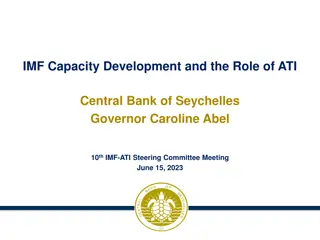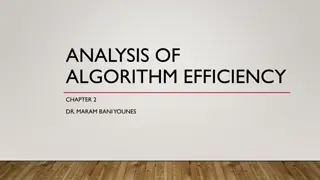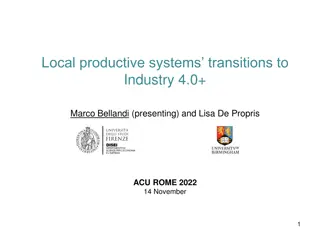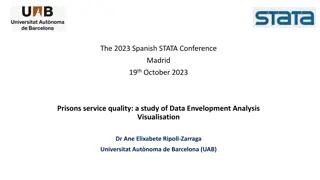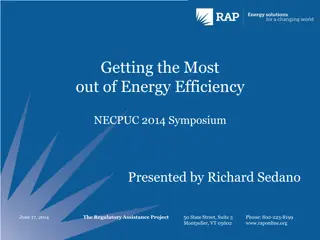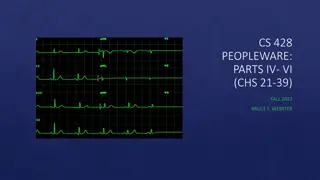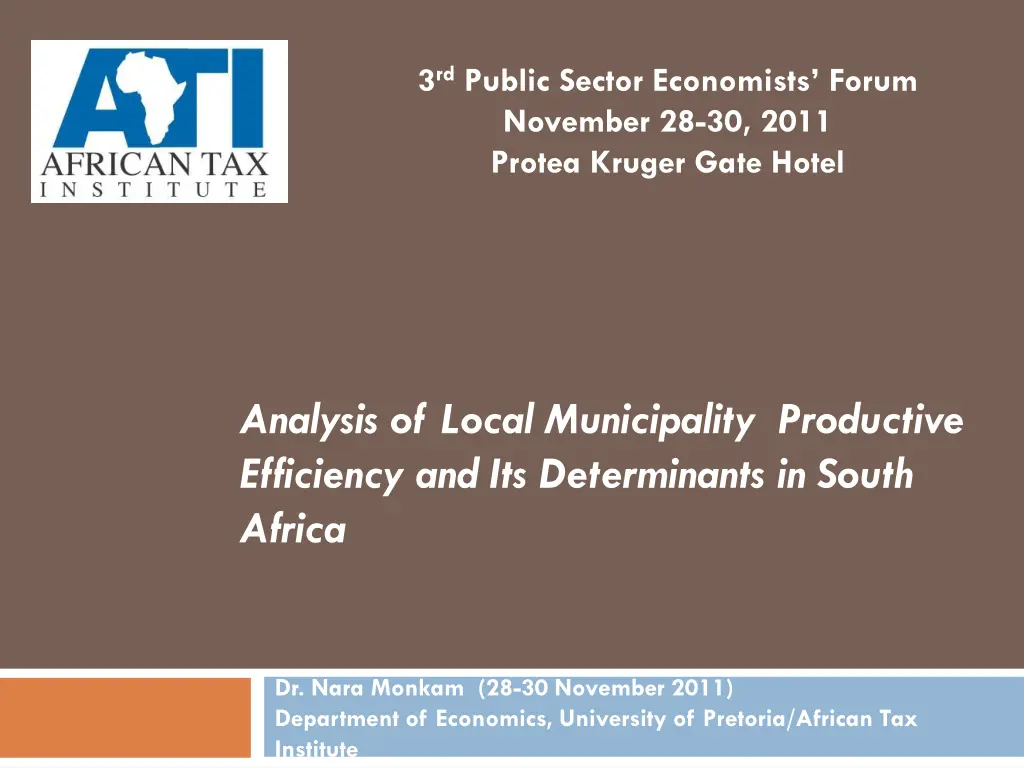
Local Municipality Productive Efficiency Analysis in South Africa
Explore the challenges and determinants affecting local municipality efficiency in South Africa, focusing on service delivery, financial management, and capacity issues. The research aims to assess the technical efficiency of 231 local municipalities in 2007 and identify factors influencing spending efficiency at the municipality level to guide policy decisions. Dive into the disparities among municipalities and categorize them based on shared challenges for a comprehensive analysis.
Download Presentation

Please find below an Image/Link to download the presentation.
The content on the website is provided AS IS for your information and personal use only. It may not be sold, licensed, or shared on other websites without obtaining consent from the author. If you encounter any issues during the download, it is possible that the publisher has removed the file from their server.
You are allowed to download the files provided on this website for personal or commercial use, subject to the condition that they are used lawfully. All files are the property of their respective owners.
The content on the website is provided AS IS for your information and personal use only. It may not be sold, licensed, or shared on other websites without obtaining consent from the author.
E N D
Presentation Transcript
3rdPublic Sector Economists Forum November 28-30, 2011 Protea Kruger Gate Hotel Analysis of Local Municipality Productive Efficiency and Its Determinants in South Africa Dr. Nara Monkam (28-30 November 2011) Department of Economics, University of Pretoria/African Tax Institute
Overview 1. Research problem and objective 2. Analysis of local efficiency performances in RSA 3. Analysis of the main determinants of local efficiency performance in RSA 4. Preliminary conclusions and policy recommendations
Research Problem Growing dissatisfaction with service delivery at the local level, characterized by service delivery protests and strikes Local municipalities are plagued by significant service delivery and backlog challenges, poor financial management and poor capacity due to lack of skills. Great number of local municipalities in financial distress (CoGTA 2009) Questions have been raised concerning their capability to efficiently deliver on expected outcomes on a sustainable basis Therefore and perhaps most alarmingly, necessity to envisage a reverse tendency toward centralization?
.Thus the Research Objectives Importance to get an overall picture of the productive or technical efficiency of 231 local municipalities in South Africa in 2007
Research Objectives Assess the productive or technical efficiency of the 231 local municipalities in South Africa for the year 2007 where productive or technical efficiency ensures that the best possible or the maximum local public services (i.e. outputs) are provided at the lowest possible cost (i.e. inputs) Investigate the empirical determinants of spending efficiency at the municipality level in South Africa to inform policy decisions regarding contributory external and internal factors influencing the effectiveness and capability of municipalities in the country.
Analysis of local efficiency performances in RSA Great disparity within and across municipalities in terms of conditions and challenges they face in fulfilling their service delivery obligations => system of categorization of municipalities in RSA Municipalities within the same cluster would share similar challenges in terms of revenue mobilization, urbanization, immigration, unemployment, poverty, and human resource and institutional capacity (CoGTA 2009) So important to disaggregate the analysis following this typology in order to account for these wide disparities
Classification of municipalities in South Africa Category Description A Metropolitan Municipalities: Large urban complexes with populations over 1 million and accounting for 56 percent of all municipal expenditure in the country B1 Local Municipalities with large budgets and containing secondary cities B2 Local Municipalities with a large town as a core B3 Local Municipalities with small towns, with relatively small population and significant proportion of urban population but with no large town as a core B4 Local Municipalities which are mainly rural with communal tenure and with, at most, one or two small towns in their area C1 District Municipalities which are not water service authorities C2 District Municipalities which are water service authorities
Local government structure in RSA since 1993 Type and Category of Municipality Type of Settlement Interim Constituti on 1993- 1996 - 1996 Constitutio n-2000 After Dec. 5th 2000 After May 18th 2011 Metropolitan (Category A) Local (Category B) District (Category C) Total Urban - 6 8 Urban and Rural Rural - - 231 226 - - 47 44 1200 843 284 278
Analysis of local efficiency performances in RSA Focus of the research: Study of the relative production efficiency of 231 South African local municipalities in 2007 within each of the four municipal clusters, namely: B1; B2; B3, and B4. Municipalities C1 and C2 are excluded because district municipalities are in general only authorized to provide water and sanitation services Municipalities A are also excluded because of data limitation
Empirical methodology Most of the existing literature on the local government efficiency have exploited: The nonparametric (DEA) technique to study local efficiency performances and, A censored normal Tobit regression model in the second-stage analysis to assess what factors may impinge on the efficiency level of municipal services provision Similar approach in this paper
Empirical methodology Basic DEA technique: Assuming there are n municipalities (or DMUs), each one with m inputs and s outputs, The efficiency score of DMU0 relative to other DMUs is obtained by solving a linear programming model In general, the best-performing DMUs in the set would have an efficiency score of one while the performance of others DMUs would vary between zero and one relative to this best performance
Input and output measures Municipal outputs: Proxies for the main basic services that local governments are mandated to provide under Schedules 4B and 5B of the Constitution number of consumer units receiving water (inside the yard, less than 200m from yard, and more than 200m from yard), number of consumer units receiving sewerage and sanitation (flush toilet connected to a public sewerage system, flush toilet connected to septic tank, bucket system, ventilated improved pit latrine toilet, and other) number of consumer units receiving solid waste management, number of consumer units receiving electricity Total population per municipality as a proxy for the administrative services generally provided by municipalities
Input and output measures Municipal input: total municipal operating or current expenditure Data sources: Statistics South Africa s Non-financial Census (NFC) of Municipalities for 2007, 2007 Community Survey, and the National Treasury s local government budget database (preliminary in-year figures)
Results: DEA-VRS input-oriented efficiency scores Local Municipality No. of Mun. Efficient Municipalities % of Efficient Municipalities Average Efficiency Scores RTS(VRS) ORT(IN) STAGE(2) .173 Category Efficiency Scores (VRS_TE) = 1 ALL 170 7.64% Aganang LIM352 Buffalo City EC125 83 percent Bushbuckridge MP325 King Sabata Dalindyebo EC157 Koukamma EC109 Lekwa-Teemane NW396 Mangaung FS172 Mbombela MP322 Mnquma EC122 Msunduzi KZN225 Thembisile MP315 Thulamela LIM343 Ubuhlebezwe KZN434 (13)
Results: DEA-VRS input-oriented efficiency scores The table summarizes the DEA-VRS input-oriented efficiency scores for all local municipalities in South Africa for which data is available It shows that in 2007, approximately 7.6 percent of local municipalities were efficient with an efficiency score equal to one The average efficiency scores across all municipalities was 0.173 which suggests that: On average, local municipalities in South Africa could have theoretically achieved the samelevel of output or basic services provided with about 83 percent fewer inputs In order words, in 2007, local municipalities could have theoretically extensively improved their efficiency performance without necessarily increasing their operating expenditures. However, as aforementioned, this figure masks substantial variations within and across municipalities.
Results: DEA-VRS input-oriented efficiency scores Local No. of Mun. Efficient Municipalities % of Efficient Municipalities Average Efficiency Scores RTS(VRS) ORT(IN) STAGE(2) .838 Municipality Efficiency Scores (VRS_TE) = 1 Category B1 19 47.36% Buffalo City EC125 City Of Matlosana NW403 16.2 percent Drakenstein WC023 Madibeng NW372 Mangaung FS172 Matjhabeng FS184 Mbombela MP322 Msunduzi KZN225 Stellenbosch WC024 (9)
Results: DEA-VRS input-oriented efficiency scores Local No. of Mun. Efficient Municipalities % of Efficient Municipalities Average Efficiency Scores RTS(VRS) ORT(IN) STAGE(2) .625 Municipality Efficiency Scores (VRS_TE) = 1 Category B2 24 33.33% Hibiscus Coast KZN216 King Sabata Dalindyebo EC157 37.5 percent Mafikeng NW383 Moqhaka FS201 Mossel Bay WC043 Msukaligwa MP302 Oudtshoorn WC045 Randfontein GT482 (8)
Results: DEA-VRS input-oriented efficiency scores Local No. of Mun. Efficient Municipalities % of Efficient Municipalities Average Efficiency Scores RTS(VRS) ORT(IN) STAGE(2) Municipality Efficiency Scores (VRS_TE) = 1 Category B3 79 10.12% .201 Abaqulusi KZN263 Amahlathi EC124 79.9 percent Koukamma EC109 Lekwa-Teemane NW396 Maluti A Phofung FS194 Matatiele EC441 Mkhondo MP303 Ngwathe FS203 (8)
Results: DEA-VRS input-oriented efficiency scores Local No. of Mun. Efficient Municipalities % of Efficient Municipalities Average Efficiency Scores RTS(VRS) ORT(IN) STAGE(2) .377 Municipality Efficiency Scores (VRS_TE) = 1 Category B4 48 18.75% Aganang LIM352 Bushbuckridge MP325 62.3 percent Greater Tzaneen LIM333 Mnquma EC122 Msinga KZN244 Nongoma KZN265 Thembisile MP315 Thulamela LIM343 Ubuhlebezwe KZN434 (9)
Results: DEA-VRS input-oriented efficiency scores Robustness check: The number of households receiving basic local services is also used as measure of municipal output This measure represents the demand side of basic local services and is collected in the Stats SA 2007 Community Survey Overall, the results point to significant differences in the DEA efficiency scores whether we consider the supply side or the demand side of the basic local service delivery
Analysis of the main determinants of local efficiency performance From the previous literature on local government efficiency, the 2011 Financial and Fiscal Commission report and from the 2009 CoGTA report, various factors have been identified that would likely have an impact on the technical efficiency of municipalities in the South African context Potential determinants of spending efficiency identified here are limited to those for which a quantifiable measure is readily available.
Analysis of the main determinants of local efficiency performance Fiscal autonomy: measured as local taxes and service charges as a percentage of total revenue (measure of revenue decentralization) Dummy Variable = 1 if the municipality has the powers and functions allocated to provide all four basic services: water, electricity, sewerage and sanitation, and solid waste management (measure of expenditure decentralization) Institutional capacity of municipalities assessed by: Job vacancy in local government and the education level of the municipal managers (MMs), the chief financial officers (CFOs), and the managers for technical services (TSMs)
Analysis of the main determinants of local efficiency performance Socio-economic factors such as income and average education levels of citizens Population growth Political leadership of a municipality, as measured by the percentage of council seats held by the majority party Number of Consumer Units receiving free water, electricity, sewerage and sanitation, and solid waste management from municipality
Analysis of the main determinants of local efficiency performance Data sources: 2007 Community Survey, Statistics South Africa 2007 Non-Financial Census of Municipalities, Statistics South Africa (P9115 Unit data 2007) National Treasury, Local Government Budgets and Expenditure Review (preliminary in-year figures) Municipal Demarcation Board Capacity Assessment Database 2007/08 The Independent Electoral Commission
Results: Censored normal Tobit regression model Regression Table In this second stage analysis, the Tobit regression model was run on all local municipalities for which data is available because there were not enough observations to estimate a separate regression for each municipal category. Three models are estimated depending on the type of the political variable used. The overall similarities in terms of the statistical significance and the sign of the estimated coefficients show that the results are somewhat robust to alternative specifications.
Results: Censored normal Tobit regression model Results: Positive impact of fiscal autonomy on municipal performance efficiency Confirms the traditional fiscal decentralization theory that a greater fiscal autonomy is expected to allow sub-national government officials to better match expenditures with revenue needs and increase their accountability in terms of spending
Results: Censored normal Tobit regression model power_func has no significant impact on local efficiency except in the third model specification where it takes on the expected positive sign The interaction term between this dummy variable and the fiscal autonomy appears to have a negative and significant impact on efficiency .Puzzling result May probably be influenced by the wide disparities across local municipalities in their ability to raise revenues
Results: Censored normal Tobit regression model Significant and negative effect of the vacancy rate in section 57 on efficiency. This confirms the premise that a higher proportion of job vacancy within a municipality would reflect its difficulty to attract qualified and experienced MMs, CFOs, and other managers and it is thus bound to impact the day-to-day functioning of the municipality and therefore its efficiency in service delivery. On the other hand, the vacancy rate within the organogram has no significant effect on local efficiency.
Results: Censored normal Tobit regression model Positive impact of the education level of (MMs) who are the top management of a municipality s administration and also the accounting officers of the municipality. If a MM holds a postgraduate degree (Honours, Masters, or PHD), the efficiency score of the municipality he/she is managing would be 0.170 points higher than a municipality headed by a MM with no postgraduate degree. However, the education level of CFOs, and managers for technical services have no significant impact on efficiency.
Results: Censored normal Tobit regression model Education level of the citizens does not appear to significantly affect efficiency levels But in model 3, percentage of the municipal population with a secondary education appears to be positively related to the spending efficiency In terms of income, the higher the percentage of the population with a gross monthly income greater than 12800ZAR, the lower the efficiency levels
Results: Censored normal Tobit regression model These results likely provide a picture of the democratic behavior at the local government level in SA: It appears that higher-income and highly educated households in SA do not feel the incentive or the need to be active participants in local decision-making processes May be explained by a political system perceived as unresponsive and dominated by a partidocracia (i.e. a political party domination) Which tend to hamper citizen s motivation to be politically interested and participatory On the other hand, lower-income and less educated households would tend to be more involved because they are more likely to depend to a greater extent on local public services
Results: Censored normal Tobit regression model Finally, it appears that the number of consumer units receiving free water and sanitation in local municipalities are also important in improving local efficiency Finally, spending efficiency is also positively related to the political leadership of a municipality Additionally, results showed that a majority party that had more than 50% of seats after the 2006 LGE had a greater efficiency performance than a majority party with less than 50% of seats
Preliminary conclusions and policy recommendations Based on the results of the DEA-VRS input-oriented efficiency scores for local municipalities in SA: On average, municipalities in SA could have theoretically achieved the same level of output or basic services provided with about 83% fewer inputs On average, B1 and B3 municipalities could have theoretically achieved the same level of basic services with about 16% and 80% fewer resources respectively; The difference between the most efficient and the least efficient municipalities being quite substantial.
Preliminary conclusions and policy recommendations Based on the results of the DEA-VRS input-oriented efficiency scores for local municipalities in SA: B4 municipalities could have theoretically achieved the same level of basic services with about 62% fewer operating expenditures. These findings raise concerns over the future of local municipalities in SA, especially B3 and B4 municipalities, about their capability to efficiently deliver on expected outcomes on a sustainable basis.
Preliminary conclusions and policy recommendations Overall, the results point to significant differences in the DEA efficiency scores whether the supply side or the demand side of the basic local service delivery is considered: From the demand side, B3 and B4 municipalities appear to have higher efficiency scores on average in 2007 compared to the same municipalities in the supply side. The least efficient municipalities are now B2 municipalities with an average efficiency score of 0.219 (i.e. same level of outputs with 78% fewer inputs)
Preliminary conclusions and policy recommendations Need to improve the second pillar of fiscal decentralization by assigning greater revenue autonomy to local municipalities, taking into account wide disparities across municipalities in their abilities to raise revenues Corollary: need to improve the allocation of local municipalities equitable share of national revenue Especially transfer allocations to B3 and B4 municipalities
Preliminary conclusions and policy recommendations Need to increase the number and skills levels of the top management of a municipality s administration (MM, CFO, TSM) Corollary: necessity to devise incentive mechanisms to attract managers, specially in secondary cities and rural areas
Preliminary conclusions and policy recommendations In a context where the political system is perceived as unresponsive and dominated by a partidocracia , Need to devise new participatory methods to increase citizen participation in local governance Public forums, public debates, popular communication outlets such as radio, soap opera, etc. Need to create new spaces in which citizens of all economic and social groups would engage with LG, would mobilize and make demands, put pressure on LG officials and monitor their performance to ensure an efficient provision of services But might not work if motivation of local officials is to keep control
Preliminary conclusions and policy recommendations Overall, given the substantial disparities within and across municipalities: It appears essential to reform the expenditure and revenue assignments under the current fiscal decentralization framework in order to reflect and accommodate disparities in jurisdictional needs and financial and functional capacities Do away with the one size fits all that characterizes the intergovernmental fiscal relations in the country




